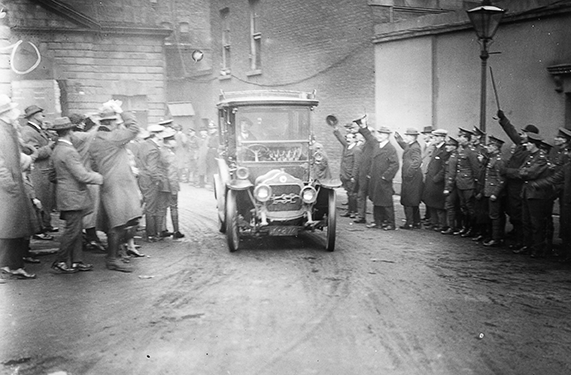‘DUBLIN CASTLE HAS FALLEN!’—COMMEMORATING THE ‘HANDOVER’
Published in Issue 1 (January/February 2022), News, Volume 30By John Gibney
Two days before the signing of the Anglo-Irish Treaty in London on 6 December 1921, Arthur Griffith wrote to Eamon de Valera in Dublin, telling him that David Lloyd George and the other British negotiators had told him that, if he and his colleagues were to sign it, ‘they would hand us over Dublin Castle and withdraw their troops from the country’. They signed it two days later, and the story of the negotiations that led to the Treaty is explored in the National Archives’ major centenary exhibition The Treaty, 1921: records from the archives, currently on display—appropriately enough—in Dublin Castle until the end of March. It is being presented by the National Archives in partnership with the Royal Irish Academy, the Office of Public Works and the National Library of Ireland, with additional records from the collections of the Military Archives and University College Dublin. The RIA’s Documents on Irish Foreign Policy (DIFP) project played a central role as a partner in the exhibition, developing the exhibition text and co-curating the structure and content for the exhibition. The story of the negotiations can be overshadowed by the acrimonious split over the Treaty. What is even less well known, however, are the procedures that slowly but surely brought the Treaty into effect, and Dublin Castle had a central role to play within that.
The last two articles of the Treaty set the stage for the handover of power from British to Irish hands. The British never formally recognised the Dáil, so Article 17 specified that the Treaty had to be ratified by a meeting of MPs elected to the putative ‘Parliament of Southern Ireland’ established by the Government of Ireland Act, 1920. This was effectively a meeting of the pro-Treaty TDs of the Second Dáil, along with the four Unionist MPs returned for Trinity College, Dublin, and took place in the Mansion House on 14 December 1922. In accordance with Article 18 of the Treaty, it also established a Provisional Government, led by Michael Collins, that was to oversee the transition of power until the Irish Free State formally came into being on 6 December 1922.

Above: Michael Collins entering Dublin Castle in a taxi on 16 January 1922. (Pathé News)
The British were preparing to withdraw from Ireland (oddly, the profound reality of the British military withdrawal from Ireland in the months that followed is often skimmed over in accounts of the period) but this would not begin until there was something that could take their place. And so, on 16 January 1922, the Provisional Government made their way to Dublin Castle to be formally installed as the new power in the land by the outgoing viceroy, Lord FitzAlan. Dublin Castle had a real and a symbolic importance, not only as the centrepiece of the British administration in Ireland but also as the complex that was seen to symbolise British misrule in Ireland. ‘Dublin Castle’, Eamon Broy later recalled, was ‘believed by the people to be the centre and focus of all that was evil and secret and sinister.’ It is often assumed, and it was claimed at the time, that the brief procedural meeting that took place between the incoming Provisional Government and the viceroy constituted the ‘surrender’ or ‘handover’ of the castle. It was nothing of the sort, for the Provisional Government would not finally take possession of the castle until the following August, but the meeting on 16 January had an undeniable resonance, as a milestone in the British withdrawal from (‘Southern’) Ireland and the establishment of an independent Irish state.
The centenary of the ‘handover’ of Dublin Castle will be officially marked on Sunday 16 January 2022 but the questions about what actually happened that day and its significance are teased out in a new illustrated book from the RIA—The handover: Dublin Castle and the British withdrawal from Ireland, 1922. The Treaty itself was the subject of a recent History Ireland Hedge School (available now as a podcast). The handover (or otherwise) of Dublin Castle will be explored in a ‘live’ Hedge School in the castle’s Chapel Royal on 6 January 2022. It will also be the subject of a separate academic conference, organised by Trinity College, Dublin, in the castle’s Printworks on 14–15 January 2022, which will also be livestreamed.
John Gibney is Assistant Editor with the Royal Irish Academy’s Documents on Irish Foreign Policy series.
- History Ireland Hedge School, ‘Dublin Castle has fallen!’—the handover, 16 January 1922, 3pm, Thursday 6 January 2022, Chapel Royal, Dublin Castle.
- Academic conference on the handover (TCD), the Printworks, Dublin Castle, 14–15 January 2022.
- The Treaty, 1921: records from the archives (NAI), Coach House, Dublin Castle, until the end of March 2022.
- In Our Own Image: Photography in Ireland, 1839 to the present (OPW), the Printworks, Dublin Castle, until 6 February 2022.
- John Gibney and Kate O’Malley, The handover: Dublin Castle and the British withdrawal from Ireland, 1922 (RIA, 2022).


















